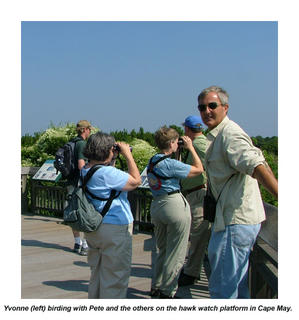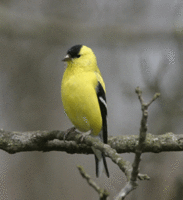 August 30, 2005: Much needed R & R
August 30, 2005: Much needed R & RSpent the morning traveling “down the shore” and the afternoon in Ocean City, NJ among the Sanderlings and the Laughing Gulls. Due to the side effects of Hurricane Katrina, the water was choppy and there was a brisk wind which seemed to please the surfers. It’s always so relaxing just to listen to the surf. I would’ve stayed all day, but high tide forced me off the beach. I arrived at the Crouch’s (Ron and Yvonne) about 6:15 pm and spent the evening catching up with them over a wonderful dinner of vegetable pasta, whole grain bread, and Pinot Grigio.
August 31, 2005: A bad day birding is still better than a good day at the office!Yvonne and I met our group leaders, Pete Dunne and Louise Zemaitis, by 7 am at the Cape May Point lighthouse. There were 18 of us present for the Warblers, Vireos, and Flycatchers workshop offered by the CMBO.
The weather had turned significantly more humid overnight and the winds were out of the south. Pete sheepishly shuffled his feet and suggested a change in the workshop name to shorebirds. A south wind is very bad for migrating passerines and he confessed that it would probably not be a good day for the workshop’s subject. However, being the troopers that he and Louise are, they sheparded us down to Higbee’s Beach anyway. The morning flight counter has already vacated his post - a very bad sign since it signified the morning migration was already complete. We birded from the parking lot down to the flight center and managed to see some birds and even a few good ones at that. Hooded warbler, Worm-eating warbler, Red-eyed vireo, many American redstarts, *Northern waterthrush, Prairie warbler, Black & white warbler, and Yellow-billed cuckoo topped the list. Also seen were: Gray catbird, Tufted titmouse, Carolina chickadee, Eastern kingbird, Northern cardinal, Barn swallow, Tree swallow, Purple martin, American crow, Common grackle, Downy woodpecker and Willet. That makes 6 warblers, 1 vireo, and 1 flycatcher by 10 am.
After 10am, Higbee’s pretty much dried up completely and we traveled back to the point to check out some of the other bird life. The newly rebuilt dunes at the point prevent anyone from seeing the ocean from the hawk watch platform or the sea watch platform. It makes birding from these points much more challenging. We did find Osprey, Peregrine falcon, Turkey vulture, Kestrel, Greater and Lesser yellowlegs, Semipalmated sandpiper, Sanderlings, *Buff-breasted sandpiper, Piping plover, Black-bellied plover, Least sandpiper, Common tern, Royal tern, Forster’s tern, *Sandwich tern, Great black-backed gull, Herring gull, Laughing gull, Parastic jaeger, Double-crested cormorant, Black duck, Mute swan, and Great egret.
We spent the afternoon at the Goshen center viewing warbler slides prepared by Louise. She gave us great tips on differentiating between species and had numerous slides of both males and females. We were unable to head to Jake’s Landing when the show was done due to a really bad 3-car accident right outside the center, however, we did add a Ruby-throated hummer to our list for the day while we were waiting to leave the parking lot.
There were two high points for the day. First, I met a woman in our group who lives in Berks county. We exchanged contact information and will hopefully be able to do some local birding together. The second great thing was that I had my very favorite dinner in the ENTIRE world tonight: Curry tofu roma from Cape Orient. If you ever get to Cape May, you have got to try it. There’s nothing better :-)
September 1, 2005: What a difference a day makes!
The winds lessened and shifted from south to north overnight which also brought a relief to the stifling humidity of yesterday. What a difference!
Yvonne and I stopped by the concrete ship before meeting the group this morning and we were privileged to see a King eider on the beach among a dozen or so Herring gulls. The eider was preening while the gulls scavenged through the seaweed. After we met up with the group, we traveled once more to Higbee’s beach which is
the place to be during passerine migration. From the parking lot we saw American redstart (many, many), Black & white warbler, Black-throated blue warbler, Northern waterthrush, Prairie warbler, Blue-winged warbler, Worm-eating warbler, Common yellowthroat, *Chestnut-sided warbler, several Blackburnian warblers, and a *Tennessee warbler (that’s 11 species!). In addition to the Red-eyed vireo, today we also heard a White-eyed vireo (“Spit, see if I care, spit!”).
We also got absolutely fabulous looks at 4 Great-crested flycatchers one of which displayed his plumage from every possible angle and then proceeded to catch and devour an enormous dragonfly right in front of us. Not to be outdone, an Eastern wood peewee performed on a branch opposite the flycatcher although his “flies” were much smaller moths, etc. Also among those tress were dozens of Eastern kingbirds, Cedar waxwings, and Baltimore orioles that flew in during the night and allowed us to looks through the scopes. Warblers for the day = 11; Vireos = 2; Flycatchers = 3 (but not 1 Empidonax sp.)
Around 10 am we hit “the Beanery” and collected Blue-gray gnatcatcher, American goldfinch, Cooper’s hawk, Ruby-throated hummingbird, and *Black-billed cuckoo! By noon though, it was dead as a door nail, but we all agreed to meet after lunch at the hawk watch platform for some raptors. The afternoon watch yielded Turkey vulture, Black vulture, Osprey, Kestrel, and an amazing 4 (count them 1, 2, 3, 4!) Bald eagles that could be seen together in one field of view. Pete commented that this was half of all the eagles sighted in 1979 when a total of 8 for the year were sighted.
Pete and Louise concluded the workshop with “Pishing 101” so that we can all “
pish” like the experts, well almost :-). As it was the first day of the hawk watch count, we stayed for a little more hawk/ shorebird watching and added Both Greater and Lesser yellowlegs. Today though, they stayed close to each other so that we could get good comparitive views – very considerate of them. Additionally, a small group of shorebirds flew in with Semipalmated plover, Least sandpiper, and Pectoral sandpiper. All totaled the group collected 52 species today – pretty fair! Ron, Yvonne and I ended the day at Gecko’s Mexican restaurant where we all had fajitas – yum!
All in all, not a bad couple of days… 5 lifers is nothing to sneeze at!


